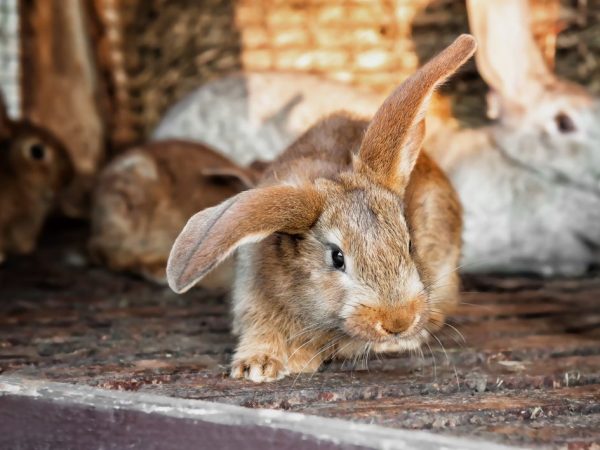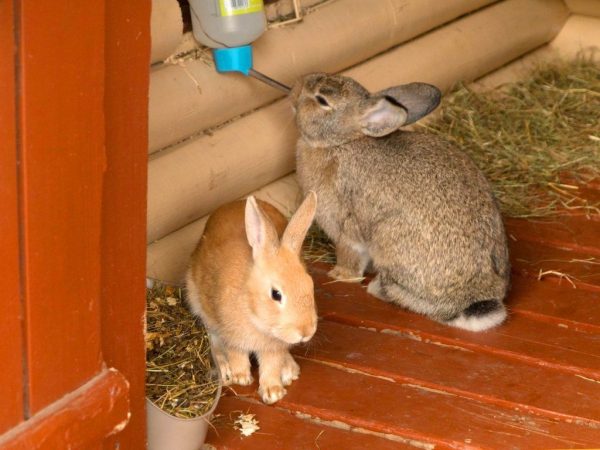How to build a rabbit shed
Rabbit breeding is a fairly popular branch of agriculture in our country. This is explained by the high value of dietary meat and rabbit furs on the market. And the maintenance of these cute mammals is not such a troublesome business.

Rabbit shed
As you know, rabbits are productive creatures. The farmer is required to provide them with decent conditions for reproduction. This article tells about what a rabbit shed should be and how you can equip it yourself using blueprints.
Housing requirements
No matter how unpretentious the heroes of this article are, they still have their own requirements for their future home. Before proceeding with the selection and arrangement of such, it is recommended to study the features of the particular breed chosen for cultivation.
Why is a shed rather than a summer cage the most suitable option for most types of rabbits? The fact is that this animal is quite thermophilic, afraid of dampness and temperature extremes. The average temperature in the rabbitry should be around 15 ° C. Therefore, before the rabbit hibernation, the owner will need to either warm the cage or build a covered room. If pets feel cold, feel discomfort, their productivity will noticeably decrease, they will become lethargic and begin to lose weight. In addition, in conditions of low temperature and drafts, rabbits can become seriously ill; the food in the trough will freeze and become unusable.
Features of arrangement
Cleaning the summer cage during the cold season is a rather problematic process. Sewage freezes, and it becomes difficult to wash or peel off, therefore, rabbit breeders advise to move pets indoors.

Setting up a rabbit shed
An ordinary barn is suitable as a rabbitry, the area of which should be 1 × 1.5 m on average. However, the dimensions may vary, depending on the size of the breed, their characteristics and the total number of pets. By design, such premises are divided into two-tiered and multi-tiered. The same cages can be placed indoors. Here is a list of general guidelines for setting up a year-round rabbit home:
- durable material (brick, foam blocks) that protects walls from drafts and other external influences;
- the presence of ventilation: rabbits need fresh air, free from harmful fumes;
- thermal insulation of the premises for the winter season;
- security: sharp corners must be avoided;
- a pitched roof is a practical option, which, moreover, looks good: the farmer will be able to dry hay on such a roof, thereby saving space inside the building;
- sloping floor to optimize the harvesting process;
- steel mesh doors as a combination of reliability and the ability of sunlight to penetrate the barn;
- manure pit;
- division into sections (females / males / young) with certain sizes, each of which will be equipped with clean and always full feeders and drinkers;
- availability of a platform for walking young animals.
When building a shed for rabbits with your own hands, you need to act according to a clear scheme. Below you will find a step-by-step instruction that will help with the systematization and direct implementation of the construction plan.
Location
The best option when choosing a place for the rabbitry will be the north side of the yard, located on a small hill and protected from the winds. It is not recommended to have water sources nearby, because a hole will have to be dug during construction.
It is very good if a tree grows near the rabbitry, under which you can hide in hot weather.
The size of the rabbitry does not exceed the size of a dwelling for other domestic animals and birds.
Construction stages
The list of tools that will be needed when building a barn for a rabbitry includes the most common nails, a hammer, mesh and plywood. It is enough for any livestock breeder to arm himself with a drawing and start directly to work.
First, you need to calculate the required area with all sizes, taking into account the number of rabbits and their gender / age. Space for cages must be spent economically, while leaving enough free space for the animals. In the drawings, you should plan the passage between the enclosures. In more detail, an approximate diagram of the future design is presented in the video.
The construction stages are as follows:
- Lay the frame. It must rise at least 80 cm above ground level.
- Erect walls, upholstery them with boards or plywood sheets. The material may be different depending on financial capabilities; the most democratic option is the foam block. The main thing is that there are no gaps between the walls.
- When dealing with the floor, it is important to think over which option will be more convenient: solid or from slats. The second option is more practical due to reasons of hygiene and the absence of drafts, especially if you equip a removable pallet below. The distance between the slats should be about 15 mm.
- It is recommended that the roof be made strong so that it can protect the rabbits from the cold in winter. A convenient option for the warm season is the folding roof. Also, you must not forget to attach a ladder to climb up. You can throw hay and grass through the sunroof.
- Divide the room into sections. Cages in ventilated areas should not be installed under the ceiling: rabbits can overheat. There are usually several types of cages in rabbitries - the choice of them depends on the breed of rabbits, their age, size and other characteristics. Usually in the middle of the room there are cages with rabbits, along the walls - with young animals. The optimal number of tiers is 2-3. Such a system will allow the owner to economically distribute the area of the shed. Only you need to install the cages in such a way that rabbit waste does not fall from the upper tiers to the lower ones. You can find a photo on the Internet that shows which option for the location of the aviary is the most convenient.
- The window area should be 8-10% of the floor area. Rabbits need natural light. Additionally, you can install an artificial one.
- Treat the walls of the room with a solution from decay and deformation of the material. This is especially true for wooden buildings. Brick, although they are quite bulky, in this regard, seem to be more reliable.
- Equip a 3 cm deep hot tub in a darkened corner and a vacuum system to provide it with water at all times.
- Allocate additional storage space for inventory, feed and other things that may be useful on the farm.
Rabbits can be kept in the same shed with chickens. The main condition is to walk these pets separately.
It is not so difficult to equip a rabbitry with your own hands. The main thing is to follow the recommendations from specialists, arm yourself with drawings and first watch a thematic video, which clearly shows the stages of the process.


